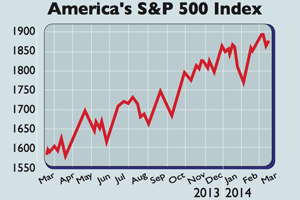
Stocks have had another bout of vertigo. America’s S&P 500 fell by 2% last week. Britain’s FTSE 100 lost almost 3%, its worst week in nine months. Traditional safe havens, such as government bonds and gold, strengthened. The latter has hit a six-month high above $1,380 an ounce.
Concerns for rattled investors include China’s slowdown, the Crimean stand-off and the prospect of tighter US monetary policy. The main problem, however, is that markets look expensive, which makes them vulnerable to any sort of bad news.
After a five-year bull run, America’s S&P 500, which sets the tone for the world, is looking overheated. According to Richard Fisher, president of the Federal Reserve Bank of Dallas, various stock-market metrics “are at eye-popping levels not seen since the dotcom boom of the late 1990s”.
The S&P’s forward price/earnings (p/e) ratio is 15.4, far above the ten-year average of 13.8. One of the most reliable long-term valuation measures, the cyclically-adjusted p/e ratio (Cape), sits at 25.1, 52% above the average for the past century. It hit 26 in early 2007, the highest since it peaked above 40 in 2000.
We have also been seeing the same sort of “outrageously expensive” technology stock valuations we saw back then, adds James Mackintosh in the Financial Times. The p/es on some small tech names are in the high hundreds. Twitter’s price-to-sales ratio has exceeded 30.
And there is no fundamental justification for it all. In 2013, the S&P 500 jumped 32% and the Nasdaq 40%, while corporate earnings barely increased. That should be a cause for concern, says Seth Klarman of Baupost Group, a hedge fund.
Earnings still show little sign of shooting up. Indeed, 85% of the S&P 500 firms that have reported on their first-quarter performance have guided expectations downwards.
All this means that US stocks, and even more attractively valued Japanese and European equities, are likely to have trouble shrugging off big-picture jitters. And it’s not just stocks, notes Klarman. Investors “would have to be blind not to see bubbles inflating in junk-bond issuance, credit quality and yields”.
Markets priced for perfection, and a shaky economic and geopolitical backdrop, are not a healthy mix.